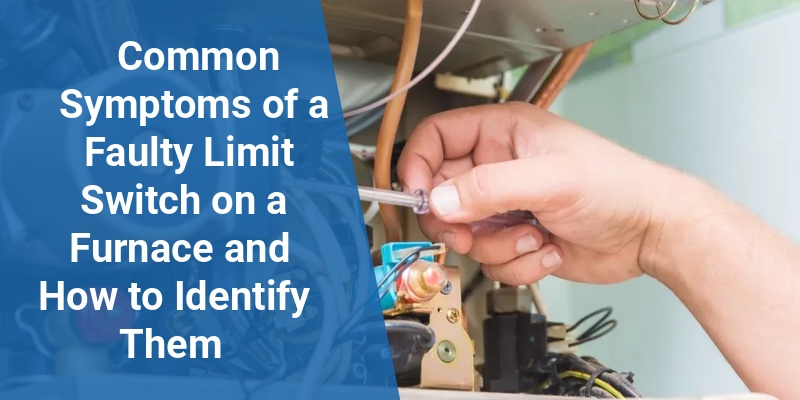A furnace limit switch plays a critical role in maintaining safe and efficient heating by regulating temperature and preventing overheating. When this component malfunctions, the furnace can experience various performance issues and safety risks. Recognizing the symptoms of a bad limit switch ensures timely repairs and prevents costly damage. This guide covers the most common signs that indicate a limit switch problem and explains why they occur.
| Symptom | Description | Potential Cause |
|---|---|---|
| Frequent Furnace Shutoffs | Furnace turns off prematurely or repeatedly during operation. | Limit switch detecting unsafe temperatures and shutting down system to prevent overheating. |
| Blower Fan Runs Continuously | Blower continues to run even after thermostat stops calling for heat. | Stuck limit switch causing blower to stay on to cool overheated furnace parts. |
| No Heat or Intermittent Heating | Furnace fails to produce heat or cycles inconsistently. | Limit switch cutting power to burners due to faulty temperature sensing. |
| Overheating and Hot Spots | Unusually hot furnace cabinet areas or heat exchanger. | Limit switch not activating properly, allowing furnace to overheat. |
| Frequent Cycling | Furnace cycles on and off rapidly. | Limit switch malfunction causing erratic system operation. |
Role of the Limit Switch in Furnace Operation
The limit switch is a vital safety device inside the furnace that monitors the temperature within the heat exchanger area. Its primary function is to prevent the furnace from overheating by interrupting the burner’s gas supply or shutting down the entire system once a preset temperature limit is reached. This helps protect the furnace components and home from potential damage or fire hazards.
Limit switches can be either manual reset or automatic reset types. When functioning correctly, they cycle the furnace on and off smoothly to maintain a safe operational temperature range, supporting efficient heating and prolonged equipment lifespan.
Symptoms Indicating a Bad Limit Switch
Frequent Furnace Shutoffs
One of the earliest signs of a failing limit switch is the furnace shutting off unexpectedly and often. Since the limit switch’s job is to safeguard the furnace by turning it off if it detects overheating, a faulty switch may become overly sensitive or send incorrect signals, causing frequent shutdowns. If this happens repeatedly, it affects comfort and drives up energy costs.
Blower Fan Runs Continuously
A stuck or malfunctioning limit switch may cause the blower fan to run constantly, even after the heating cycle ends. This occurs because the switch may incorrectly detect excessive heat and try to cool the furnace by running the blower continuously. While this may seem beneficial, it indicates a problem that should be repaired to avoid other system issues.
No Heat or Intermittent Heating
If the furnace fails to produce consistent heat or produces no heat at all despite calling for it, the limit switch could be cutting off power to the burners as a safety precaution. A defective switch might interpret normal operation as overheating, preventing the furnace from igniting properly and delivering warm air.
Overheating and Hot Spots on Furnace
A bad limit switch may fail to cut off the burner during overheating conditions, allowing the furnace cabinet or heat exchanger to become unusually hot. This is a severe safety concern because overheating can lead to furnace damage or fire risks. If hot spots are detected near the furnace, immediate inspection of the limit switch is warranted.
Call 888-906-9139 for Free Local HVAC Quotes – No Obligation, Just Savings!
Frequent Cycling of Furnace
A malfunctioning limit switch can disrupt the normal cycling process, causing the furnace to turn on and off rapidly and frequently. This short cycling not only reduces efficiency but can lead to wear and tear on the furnace components, shortening the system’s overall lifespan.
Additional Indicators of Limit Switch Problems
- Burner Lockout: Furnace repeatedly enters lockout mode, requiring a manual reset.
- Unusual Noises: Clicking or buzzing sounds near the switch area indicating electrical issues.
- Visible Damage: Corrosion, burn marks, or physical damage on the limit switch itself.
Testing and Diagnosing a Bad Limit Switch
Diagnosing a faulty limit switch requires specialized tools and safety precautions. A professional HVAC technician will perform the following steps:
- Visual Inspection: Checking for physical damage or signs of wear on the switch and wiring.
- Continuity Testing: Using a multimeter to test if the switch opens and closes properly at designated temperatures.
- Operational Testing: Monitoring furnace operation and temperatures to verify if the switch triggers correctly during heating cycles.
Never attempt limit switch testing without proper training or tools, as it involves electrical components and gas connections.
Common Causes of Limit Switch Failure
- Dust and Debris Build-Up: Dirt accumulation can affect the switch’s temperature sensor accuracy.
- Age and Wear: Over time, mechanical parts and sensors degrade from constant heating cycles.
- Poor Airflow: Dirty air filters or blocked vents cause overheating, stressing the limit switch.
- Improper Installation or Maintenance: Incorrect wiring or neglecting preventive furnace care leads to premature failure.
Preventive Measures to Extend Limit Switch Life
Regular furnace maintenance helps prolong the lifespan of the limit switch and the entire furnace system. Key practices include:
- Routine Air Filter Replacement: Clean filters improve airflow and reduce overheating risk.
- Professional Annual Furnace Tune-Up: Inspection and cleaning of furnace components ensure proper function.
- Keeping Vents and Registers Clear: Adequate air circulation prevents heat buildup.
- Prompt Repairs: Addressing minor issues before they escalate protects the limit switch and furnace.
When to Replace a Furnace Limit Switch
If symptoms persist after troubleshooting and maintenance, the limit switch may need replacement. Signs replacement is necessary include:
- Repeated furnace shutdowns despite cleaning and airflow restoration
- Continuous blower operation not fixed by resets
- Visible physical damage or corrosion
- Failed electrical continuity tests by a technician
Replacing the limit switch is generally straightforward but should be done by a qualified HVAC professional to ensure safety and proper calibration.
